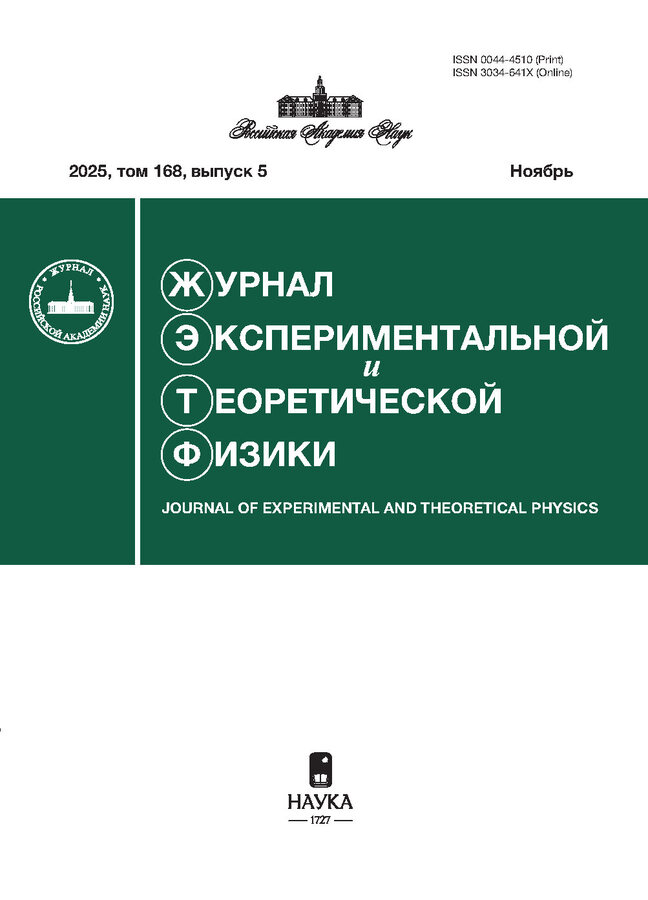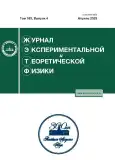Vortices on the Free Surface of a Normal Helium He-I Layer in a Wide Cell
- Authors: Levchenko A.A1,2, Mezhov-deglin L.P1,2, Pel'menev A.A1,2,3
-
Affiliations:
- Authors and Affiliations Institute of Solid State Physics, Russian Academy of Sciences
- Landau Institute for Theoretical Physics, Russian Academy of Sciences
- Chernogolovka Branch, Semenov Federal Research Center of Chemical Physics, Russian Academy of Sciences
- Issue: Vol 163, No 4 (2023)
- Pages: 545-560
- Section: Articles
- URL: https://journals.rcsi.science/0044-4510/article/view/145393
- DOI: https://doi.org/10.31857/S0044451023040120
- EDN: https://elibrary.ru/MCGOFI
- ID: 145393
Cite item
Full Text
Abstract
The appearance of a thermogravitational convective flow in the bulk of a layer of normal liquid helium He-I h ≈ 1–3 cm deep in a wide cylindrical cell, which is heated from above in the gravity field in the temperature range Tλ ≤ T ≤ Tm, is accompanied by the excitation of a vortex flow on the free surface of the liquid. Here Tλ = 2.1768 K is the temperature of transition of liquid 4He from the superfluid He-II to the normal He-I state at the saturated vapor pressure, and Tm ≈ 2.183 K is the temperature at which the He-I density passes through a maximum. Bulk convection serves as a source of energy pumped into the vortex system on the surface of He-I. The nonlinear interaction of vortices on the surface with each other and with convective vortex flows in the bulk of the layer leads to the formation of two large-scale vortices (vortex dipole) on the surface of He-I, and their sizes are limited to the diameter of the working cell and several times exceed the layer depth. This behavior corresponds to the transition from the vortex flow mode on “deep water” (vortices on the surface of a three-dimensional liquid layer) to vortices on the surface of “shallow water” (vortices on the surface of a two-dimensional layer) in time. When the layer is heated further above Tm, the convective flows in the bulk decay quickly, but the vortex motion on the surface of a two-dimensional He-I layer is retained. In the absence of energy pumping from the bulk, the total energy of the vortex system on the surface of a shallow water layer decreases in time according to a near-power law because of the nonlinear interaction of large-scale vortices with each other and friction against the cell walls. As a result, during long-term observations, small-scale vortices with sizes comparable to or less than the layer depth again begin to prevail on the surface of He-I, which corresponds to the transition from a two-dimensional to a three-dimensional liquid layer. The energy of the vortex flow on the surface of a deep water layer decreases according to a near-exponential law. Thus, long-term observations of the dynamic phenomena on the free surface of an He-I layer several centimeters deep in a wide temperature range above Tλ allowed us, for the first time, to study the excitation, evolution, and decay of the vortex flows on the surface of a deep or shallow water layer in one experiment.
About the authors
A. A Levchenko
Authors and Affiliations Institute of Solid State Physics, Russian Academy of Sciences; Landau Institute for Theoretical Physics, Russian Academy of Sciences
Email: pelmenevaa@gmail.com
142432, Chernogolovka, Moscow oblast, Russia; 142432, Moscow, Russia
L. P Mezhov-deglin
Authors and Affiliations Institute of Solid State Physics, Russian Academy of Sciences; Landau Institute for Theoretical Physics, Russian Academy of Sciences
Email: pelmenevaa@gmail.com
142432, Chernogolovka, Moscow oblast, Russia; 142432, Moscow, Russia
A. A Pel'menev
Authors and Affiliations Institute of Solid State Physics, Russian Academy of Sciences; Landau Institute for Theoretical Physics, Russian Academy of Sciences; Chernogolovka Branch, Semenov Federal Research Center of Chemical Physics, Russian Academy of Sciences
Author for correspondence.
Email: pelmenevaa@gmail.com
142432, Chernogolovka, Moscow oblast, Russia; 142432, Moscow, Russia; 142432, Chernogolovka, Moscow oblast, Russia
References
- А. А. Пельменев, А. А. Левченко, Л. П. Межов-Деглин,·Письма в ЖЭТФ 110, 545 (2019)
- A. A. Pel'menev, A. A. Levchenko, and L. P. Mezhov-Deglin, JETP Lett. 110, 551 (2019); doi: 10.1134/S0370274X19200062.
- A.A. Pelmenev, A. A. Levchenko, and L. P. Mezhov-Deglin, Low Temp. Phys. 46, 133 (2020); doi: 10.1063/10.0000531
- A. A. Pelmenev, A. A. Levchenko, and L. P. Mezhov-Deglin, J. of Low Temp. Phys. 205, 200 (2021); doi: 10.1007/S10909-021-02632-5.
- A. A. Pelmenev, A. A. Levchenko, and L. P. Mezhov-Deglin, Materials 14, 7514 (2021); doi: 10.3390/ma14247514.
- R. J. Donnelly and C. F. Barenghi, J. Phys. Chem. Ref. Data 27, 1217 (1998); doi: 10.1063/1.556028
- Л. Д. Ландау, Е. М. Лифшиц, Теоретическая Физика, том VI, Гидродинамика, Москва, Физматлит (2017)
- L. D. Landau and E. M. Lifshitz, Course of Theoretical Physics, Fluid Mechanics, Pergamon: New York, NY, USA, Vol. 6 (1987).
- А. В. Гетлинг, Конвекция Рэлея-Бенара. Структуры и динамика, Едиториал УРСС URSS, (1999), 248 ISBN 5-8360-0011-5
- A. V. Getling, Rayleigh-Benard Convection. Structures and Dynamics, Advanced Series in Nonlinear Dynamics, World Scienti c, (1998), Vol. 11.
- G. Ahlers, S. Grossmann, and D. Lohse, Rev. Mod. Phys., 81, 503 (2009); doi: 10.1103/RevModPhys.81.503.
- F. Chilla and J Schumacher, Eur. Phys. J. E 35, 58 (2012).
- P. E. Roche, J. New, Phys. 22, 073056 (2020).
- S. Moller, C. Resagk, and C. Cierpka, Exp. Fluids 62, 1 (2021); doi: 10.1017/jfm.2021.619.
- Ping Wei, J. Fluid Mech. 924, A28 (2021); doi: 10.1017/jfm.2021.619.
- J. J. Niemela and R. J. Donnelly, J. Low Temp Phys 98, 1 (1995); doi: 10.1007/BF00754064.
- Д. В. Любимов, Т. П. Любимова, A. A. Черепанов, Динамика поверхностей раздела, Физмалит, Москва (2003), c.216.
- R. W. Walden and G. Ahlers, J. Fluid Mech. 109, 89 (1981); doi: 10.1017/S0022112081000955.
- A. Sameen, R. Verzicco, and K. R. Sreenivasan, Phys. Scr. 132, 014053 (2008); doi: 10.1088/0031-8949/2008/T132/014053.
- S. Weiss, Xiaozhou He, G. Ahlers et al., J. Fluid Mech. 851, 374. (2018); doi: 10.1017/jfm.2018.507.
- Hiu Fai Yik, V. Valori, and S. Weiss, Phys. Rev. Fluids 5, 103502 (2020); doi: 10.1103/PhysRevFluids.5.103502.
- V. M. Parfenyev, S. V. Filatov, M. Yu. Brazhnikov et al., Phys. Rev. Fluids 4, 114701 (2019). doi: 10.1103/PhysRevFluids.4.114701.
- S. V. Filatov and A. A. Levchenko, J. of Surface Investigation: X-ray, Synchrotron and Neutron Techniques 14, 751 (2020); doi: 10.1134/s1027451020040072.
- S. Filatov, A. Levchenko, A. Likhter et al., Mater. Lett. 254, 444 (2019); doi: 10.1016/j.matlet.2019.07.059.
- С. В. Филатов, А. А. Левченко, Л. П. Межов-Деглин, Письма в ЖЭТФ 111, 653 (2020); doi: 10.31857/S1234567820100031
- S.V. Filatov, A.A. Levchenko, and L.P. Mezhov-Deglin, JETP Lett. 11, 549 (2020).
- А. А. Левченко, Л. П. Межов-Деглин, А. А. Пельменев, ПТЭ 6, 133 (2016); doi: 10.7868/S0032816216060264.
- A. A. Levchenko, E. V. Lebedeva, L. P. Mezhov-Deglin et al., Low Temp. Phys. 45, 469 (2019); doi: 10.1063/1.5097354.
- Е. В. Лебедева, А. М. Дюгаев, П. Д. Григорьев, ЖЭТФ, 161, 1 (2022); doi: 10.31857/S0044451022050157.
- С. В. Филатов, А. А. Левченко, М. Ю. Бражников и др., ПТЭ 5 135 (2018); doi: 10.1134/S0020441218040188
- S. V. Filatov, A. A. Levchenko, M. Yu. Brazhnikov et al., Instruments and Experimental Techniques, 61, 757 (2018); doi: 10.1134/S0032816218040201.
- Zhen-Hua Wan, Ping Wei, R. Verzicco et al., J. Fluid Mech. 881, 218 (2019); doi: 10.1017/jfm.2019.770.
- V.Srinivasan, U.Madanan, and R.J.Goldstein, Int. J. of Heat and Mass Transfer 182, 121965 (2022); doi: 10.1016/j.ijheatmasstransfer.2021.121965.
- P. Urban, P. Hanzelka, T. Kralik et al., Phys. Rev. E 99 011101(R) (2019); doi: 10.1103/PhysRevE.99.011101.
- В. П. Пешков, А. П. Боровиков, ЖЭТФ 50, 844 (1966)
- V.P. Peshkov, A. P. Borovikov, Sov. Phys. JETP 23, 559 (1966).
- Л. П. Межов-Деглин, ЖЭТФ 71, 1453 (1976)
- L.P. Mezhov-Deglin, Sov. Phys. JETP, 44, 761 (1976).
- B. Baudouy and A. Four, Cryogenics 60, 1 (2014).
- M, Thielicke and E.J Stamhuis, J. of Open Research Software, http://openresearchsoftware.metajnl.com/articles/10.5334/jors. doi: 10.5334/jors.bl.
- J. J. Niemela and K. R. Sreenivasan, J. Low Temp. Phys. 143, 163 (2006); doi: 10.1007/s10909-006-9221- 9.
- R. Colombi, N. Rohde, M. Schuter et al., Fluids 7, 148 (2022). doi: 10.3390/ uids7050148.
- С. В. Филатов, Д. А. Храмов, А. А. Левченко, Письма в ЖЭТФ 106, 305 (2017); doi: 10.7868/S0370274X1717009X.
Supplementary files










